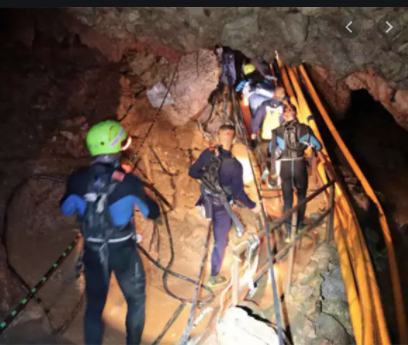At a very convivial joint meeting with the Auckland east Rotary Club, our members were treated to an extremely interesting and moving talk by Professor Simon Mitchell, one of an intrepid group of people who enjoy diving deep into the oceans and exploring large caves.
 Simon gave a very detailed account of the challenges faced and steps taken to rescue twelve soccer team boys and their coach from caves in the Tham Luang Forest Park in the far north of Thailand in July 201 Though not directly involved in the rescue he is a close friend of Richard Harris (Anaesthesist) and Craig Challen (Veterinary surgeon), two Australian divers who both received recognition as Australians of the year (2019) for their crucial part in the dramatic events.
Simon gave a very detailed account of the challenges faced and steps taken to rescue twelve soccer team boys and their coach from caves in the Tham Luang Forest Park in the far north of Thailand in July 201 Though not directly involved in the rescue he is a close friend of Richard Harris (Anaesthesist) and Craig Challen (Veterinary surgeon), two Australian divers who both received recognition as Australians of the year (2019) for their crucial part in the dramatic events.Check out all the details on You Tube but there is nothing like hearing the story first hand from such an enthusiast and knowledgeable presenter.
Some highlights:
- An appreciation of just how murky the water was in the cave sumps and how convoluted the passages through which the boys, anaesthetised and hanging from their diver rescuers, had to be negotiated.
- How easy it was to ‘lose the line’ which had been set by the first search divers. The loss of a Thai diver was attributed to this.
- An appreciation of how this became a world event with experts from the UK (Rick Stanton in particular) the USA and Thai authorities and multi-national divers involved (about 100 in total).
- How frightening it must have been for the team, in total darkness, without food and with limited water trickling down the cave walls (the water below was too polluted for safe use), in putrid surroundings with no sense of time and no realistic expectation of rescue until the appearance of the first divers after 9 days!
- The total underwater distance the boys had to be brought through – 1.2 km. with the longest section being 350 metres. The total ‘journey’ was close to 4 km.
- The risks taken in using anaesthetics as the only viable way of keeping the boys calm during the procedure and the need to re-inject (even under water) at the first signs of body movement – other that expired air bubbles. There were no precedents to follow so no guarantee of success
- The effectiveness of the full face Interspiro Divator masks which ensured constant positive airway pressure (CPAP) during the whole time.
- The selection of the first two boys to go, on the basis that they would have the furthest distance to ride their bikes home once out of the cave!

All who heard this talk could not have but been moved by the whole account – in times of Covid, such uplifting stories need to be more widely known.